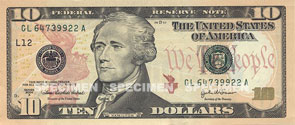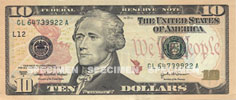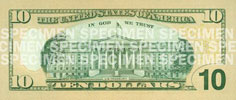Currency index
Advertisements
United States ten dollar bill

Description:
Size: 155.956 x 66.294 mm
Paper type: 75% cotton, 25% linen


The United States ten dollar bill is a
denomination of United States currency. The first U.S. Secretary of the
Treasury, Alexander Hamilton, is currently featured on the obverse of the bill,
while the U.S. Treasury is featured on the reverse. (Hamilton is one of two
non-presidents featured on currently issued U.S. bills. The other is Benjamin
Franklin, on the $100 bill. In addition to this, Hamilton is one of only two
persons featured on U.S. currency who was not born in the continental United
States, as he was from the West Indies. The other, Kamehameha I, appears on the
2008 Hawaii state quarter.) All 10 dollar bills issued today are Federal Reserve
Notes.
The Bureau of Engraving and Printing says the average life of a 10 dollar bill in
circulation is 18 months before it is replaced due to wear. Approximately 3.7% of
all US banknotes printed in 2017 were $10 bills. Ten dollar bills are delivered
by Federal Reserve Banks in yellow straps.
The source of the face on the United States $10 note is John Trumbull’s 1805 portrait of
Hamilton that belongs to the portrait collection of New York City Hall. The United States ten dollar bill ($10) is the only U.S. paper currency in circulation in which the portrait faces
to the left (the $100,000 bill featured a portrait of Woodrow Wilson facing to
the left, but was used only for intra- vernment transactions).
Security Features:
Security features can help you to tell if a 10 dollar bill is fake or real.
Color-Shifting Ink

Tilt the United States ten dollar bill ($10) to check that
the numeral 10 in the lower right-hand corner on the front of the bill
changes color from copper to green. The color shift is more dramatic on the
redesigned currency, making it even easier for people to check their money.
Watermarks

Hold the note to light to see a faint image of
Treasury Secretary Alexander Hamilton to the right of his large portrait. It can
be seen from both sides of the bill. On the redesigned $10 bill, a blank oval
has been incorporated into the design to highlight the watermark's location.
Security Thread

Hold the United States ten dollar bill ($10) to light to make sure there's a small thread
embedded in the paper. The words USA TEN and a small flag are visible
in tiny print. It runs vertically to the right of the portrait and can be
seen from both sides of the bill. This thread glows orange when
illuminated by ultraviolet light.
The redesigned currency remains the same size and uses the same, but enhanced portraits and historical images as the older-design bills, and importantly, continues to be recognized around the world as quintessentially American.
Color
The most noticeable difference in the redesigned United States ten dollar bill ($10) is the addition of subtle background colors of orange, yellow and red. The words We the People from the United States Constitution have been printed in red in the background to the right of the portrait. Also, small yellow 10s have been printed in the background to the left of the portrait on the front of the bill and to the right of the vignette on the back of the bill. The background colors add complexity to the bills and differ with each denomination to help distinguish them. Because color can be duplicated by potential counterfeiters, it should not be used to verify the authenticity of the bill.
Symbols of Freedom

A symbol of freedom representing an icon of Americana has been added to the redesigned 10 dollar bill. Two images of the torch
carried by the Statue of Liberty are printed in red on the front of the
redesigned bill. A large image of the torch is printed in the background
to the left of the portrait of Secretary Hamilton, while a second, smaller metallic red
image of the torch can be found on the lower right side of the portrait. The symbols of freedom differ for each denomination.
Updated Portrait and Vignette

The oval borders and fine lines surrounding the portrait of Secretary Hamilton on the
front, and the United States Treasury Building vignette on the back, have been removed.
The portrait has been moved up and shoulders have been extended into the
border. Additional engraving details have been added to the vignette background.
Low-Vision Feature

The numeral 10 in the lower corner on the
back of the bill is enlarged to help those with visual impairments distinguish
the denomination.
Microprinting

Because they are so small, microprinted words are
hard to replicate. The redesigned 10 dollar bill features microprinting on the front
of the bill in three areas: the word USA and the numeral 10
can be found repeated beneath the large printed torch and the words THE
UNITED STATES OF AMERICA and TEN DOLLARS can be found below the
portrait, as well as vertically inside the left and right borders of the bill.
Federal Reserve Indicators

A universal seal to the left of the portrait represents the entire Federal Reserve System. A letter and number beneath the
left serial number identifies the issuing Federal Reserve Bank. There are 12 regional Federal Reserve Banks and 24 branches located in major cities
throughout the United States.
Serial Numbers

The unique combination of eleven numbers and letters appears twice on the front of the bill. On the
redesigned United States ten dollar bill ($10), the left serial number has shifted slightly to the right,
compared with previous designs. Because they are unique identifiers, serial
numbers help law enforcement identify counterfeit notes, and they also help the
Bureau of Engraving and Printing track quality standards for the notes they produce.
Check this video of fake 10 dollar bill
In this video you can see a fake U.S 10 Dollar bill compared to a real one.
Sources:
uscurrency.gov
wikipedia.org











Follow currencyguide.eu